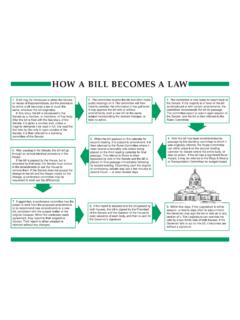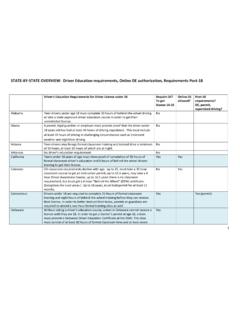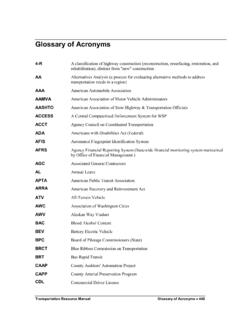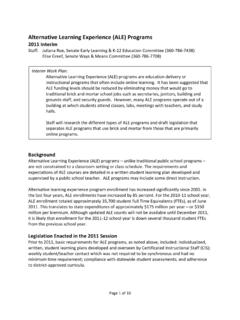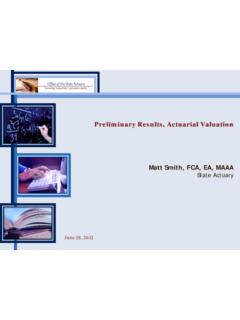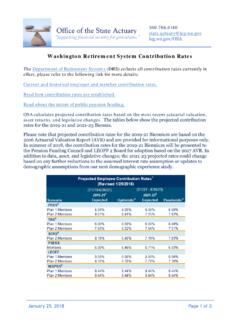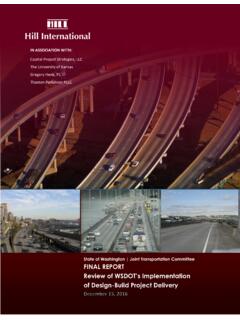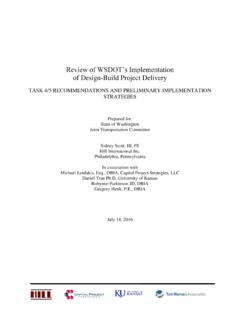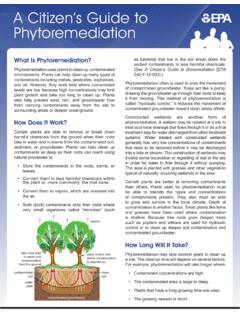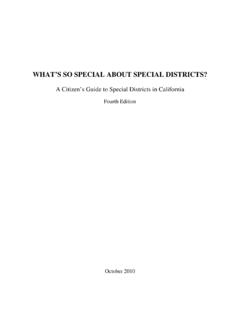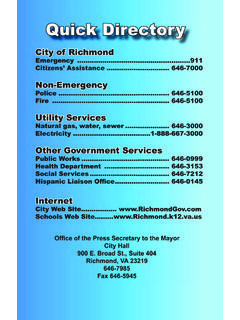Transcription of A Citizen’s Guide to Washington State K-12 Finance
1 2019 A Citizen s Guide to Washington State K-12 Finance Table of ContentsHow does recent legislation affect K-12 instruction and funding of basic education?.. 2 How many students attend K-12 schools in the State ?.. 3 How are public schools in Washington organized?.. 3 What does the Washington State Constitution provide regarding K-12 public schools?4 How has this constitutional provision been interpreted in the State courts?.. 4 What is the McClearydecision?.. 5 How has the State implemented the Program of Basic Education?.. 8 What is the role of the federal government in public elementary and secondary education?.. 17 What is Initiative 1351?.. 18 How much of the State near-general fund is spent on K-12 public schools?.. 19 How do school districts receive local funding?.. 20 What is Local Effort Assistance and Levy Equalization?.. 21 How does the State lottery support public schools?.. 22 What are other types of dedicated funding utilized by school districts?
2 24 How is school construction funded in the State ?.. 24 How has the amount of the near-general fund support of K-12 public schools changed since 2005?.. 25 How much of total K-12 funding comes from the State ?.. 27 What are school district expenditures by activity?.. 28 What are school district expenditures by student and program?.. 30 How has totalper-student spending changed since 2000?.. 32 How has stateper-student funding changed since 2000?.. 33 How is the salary level for teachers determined?.. 33 What is the average salary level for teachers?.. 36 How is the salary level of administrators and classified staff determined?.. 36 How does Washington fund school employee health benefits?.. 37 How does Washington compare to other states?.. 391 IntroductionThe 2019 Citizen s Guide to K-12 Financeis offered to provide a clear and simple overview of K-12 financial issues. It provides general information on K-12 Finance by answering frequently asked questions.
3 For more in-depth information of K-12 Finance , see Organization and Financing of Washington Public Schoolspublished by the Office of Superintendent of Public Instruction (OSPI). It is available at: The information presented in this document is based on statewide data. For information on a specific school district, inquire with that school district. Detailed K-12 fiscal data, on both statewide and district-specific levels, are also reported on the Washington State fiscal transparency website at: 2019 Citizen s Guide to K-12 Financewas prepared by non-partisan Senate Committee Services staff supporting the Senate Ways and Means Committee and the Senate Early Learning & K-12 Committee) with the assistance of staff of the Legislative Evaluation and Accountability Program (LEAP) regarding the Guide or requests for additional copies should be addressed to:Senate Ways and Means Committee311 John A. CherbergOlympia, Washington 98504-0482 Telephone: 360-786-7715 Fax: 360-786-7615 does recent legislation affect K-12 instruction and funding of basic education?
4 In the 2009-11 biennium, two pieces of legislation were enacted to redefine the program of basic education and restructure K-12 funding allocation formulas. The first bill, Engrossed Substitute House Bill (ESHB) 2261 (Chapter 548, Laws of 2009), expanded the definition of basic education to include increased instructional hours, an opportunity to complete 24 credits for high school graduation, full-day kindergarten, a program for highly capable students, and student transportation to and from school. The bill also created the framework for a new distribution formula for the basic education instructional funding allocation based on prototypical schools and a new funding formula for student transportation. The changes took effect September 1, 2011 under an implementation timeline set by the Legislature. The Legislature also reaffirmed that the program of basic education includes special education programs for students with disabilities; the Transitional Bilingual Instructional Program (TBIP); the Learning Assistance Program(LAP), which provides remedial education; and the education of students in residential programs, juvenile detention, and adult correctional facilities.
5 In ESHB 2261, the Legislature also declared its intent to enhance the salary allocation model. The second bill, Substitute House Bill (SHB) 2776 (Chapter 236, Laws of 2010), enacted in statute the funding formula values for the new prototypical schools model at levels that represented what the State was spending on basic education at the time. It set targets and established a timeline for phasing in enhancements to the funding and instructional program of basic education, including pupil transportation, all-day kindergarten, K-3 class size reduction to 17 students per teacher, and increased funding for materials, supplies and operating costs (MSOC).These enhancements are fully implemented with the 2017-18 school year(SY).The stated intent of the new funding model was to provide the legislature's definition of basic education once fully implemented. The bills also require school district reporting of actual staffing and expenditures, compared to the funding provided in the prototypical model.
6 Thecomparisons are available on a public website of the Office of the Superintendent of Public Instruction: enactment of Engrossed House Bill (EHB) 2242 (Chapter 13, Laws of 2017, 3rd special session) and its implementing appropriations in the 2017-19 operating budget increased State allocations for school staff salaries and changed the way these salaries are established and adjusted in the future. Under these reforms, future State salary allocations will be updated, if necessary, to ensure that State basic education allocations continue to 3provide market-rate salaries and that regionalization adjustments reflect actual economic differences between school districts. In addition, EHB 2242 provides new State common school tax revenues, increases State programming and funding for a number of K-12 basic education programs, reforms how local levy revenues are calculated and their uses, and enacts other reforms to further increase the transparency, accountability, and efficiency of school funding.
7 A more detailed description of these changes is provided in later parts of this document. Additional information regarding this legislation is also provided on OSPI's public website: changes were made to K-12 funding with the enactment of Engrossed Second Substitute Senate Bill (E2 SSB 6362) (Chapter 266, Laws of 2018, regular session). The most significant changes included movingahead the schedule for increased State salary allocations for school employees to the 2018-19 school year, increasing the special education excess cost multiplier, adding another regionalization adjustment, and adding an experience factor to provide additional funding to school districts that meet certain instructional staff many students attend K-12 schools in the State ? In the 2017-18 school year, the most current year for which data is available, over 1,093,200 students were enrolled at 2,453 public schools across the State . In addition, it is estimated that about 81,943 students attended private schools and 21,022 students received home-based instruction during the 2017-18 school are public schools in Washington organized?
8 The public school system in Washington involves various entities at both the State and local levels, including the Legislature, the Governor, the State Board of Education, OSPI, the federal Department of Education, the State Auditor s Office, the Professional Educator Standards Board, Educational Service Districts, the Washington State Charter School Commission, and local school districts. Each of these entities plays a role in establishing educational policies, implementing these policies, or providing administrative and financial oversight of the public school is largely considered a "local control" State . Each school district is governed by a locally-elected school board whose members serve staggered four-year terms. Local school district boards have broad discretionary power to determine and adopt policies not in conflict with other law that provide for the development and implementation of 4instructional programs, activities, services, or practices that the school district board of directors determine will promote education or effective management and operation of the school district.
9 Currently, there are a total of 295 school districts. Each school board hires a Superintendent who oversees the day-to-day operation of the school district. What does the Washington State Constitution provide regarding K-12 public schools?"It is the paramount duty of the State to make ample provision for the education of all children residing within its borders, without distinction or preference on account of race, color, caste or sex." Washington Constitution, article IX, section 1 This constitutional provision is unique to Washington . While other states have constitutional provisions related to education, no other State makes K-12 education the "paramount duty" of the has this constitutional provision been interpreted in the State courts?There have been a handful of Washington State Supreme Court cases that have addressed basic education under Article IX of the Washington Constitution. The Court has interpreted Article IX, section 1 of the State constitution to mean that the State must define a "program of basic education", within the guidelines of the Court, distinguished from all other educational programs or services, and amply fund it from regular and dependable sources that cannot be dependent on local tax Court has found that this "paramount duty" is superior in rank and above all others.
10 Neither fiscal crisis nor financial burden changes the Legislature s constitutional duty. The State has no duty to fund programs outside the definition of "basic education." School districts may use local property tax levies to fund enrichment programs and programs outside the legislative definition of basic education. However, the use of local levies cannot reduce the State s obligation to fund basic Court does not require the State to provide a total education or the offerings of all knowledge, programs, subjects or services; however, the duty goes beyond mere reading, writing, and arithmetic. The Court has noted that a basic education also "embraces broad educational opportunities needed in the contemporary setting to equip children for their role as citizens and as 5potential competitors in today s market as well as in the marketplace of ideas." Additionally, the Court found that the education required by the constitution does not reflect a right to a guaranteed educational Court has acknowledged that the Legislature has an obligation to review the definition of a basic education program as the needs of students and the demands of society evolve.
